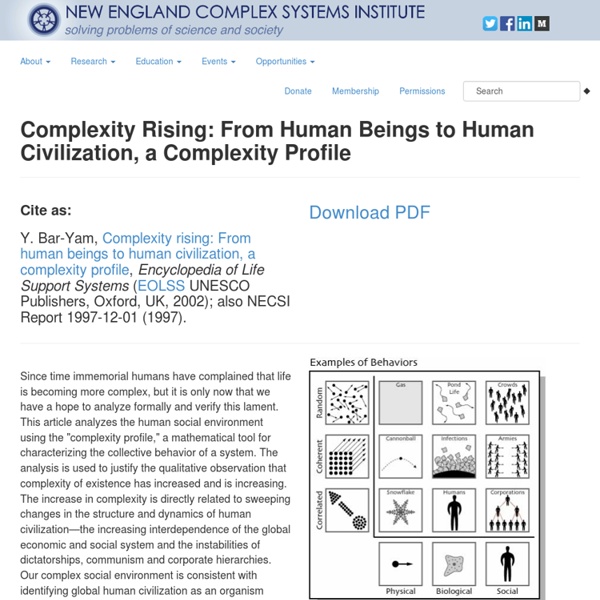



ECCS 2011 - Satellite UCD Home | About UCD | UCD News & Events | Virtual Tour | Contact UCD | Staff Directories | UCD Sitemap | UCD Connect "Computing Life, Understanding Worlds" Learn more.. Join our Community Facebook Twitter Linked In Subscribe to our podcasts YouTube Subscribe to our news feed Join our Mailing List For announcements on Seminars, Events and News People Director's Welcome » Meet our internationally respected researchers Locate a Researcher » Use our People Finder application to search for a researcher Our Expertise » CASL Academics who can provide expert comment Research Programmes » Natural Computing and Optimisation » Simulation Science and Extreme Events » Networks and Data Analysis » Security and Trust Upcoming Events CASL Intranet Privacy | Freedom of Information | Disclaimer | Sitemap | © Copyright Complex and Adaptive Systems Laboratory, University College Dublin 2010
Customized Blended Learning: The Classrooms of the Future? Online colleges may offer lessons that are personalized—to a degree. But not to the degree found at Summit High, a California charter school. The school has launched a test program that lets students personalize their own learning to an unprecedented degree. In a ninth-grade math class, some students work on geometry exercises, while others take tests in algebra, probability, and long division. Students work online, in large-group, teacher-led instruction, and in small groups. Kids get to choose the type of instruction they want—and the teacher can monitor everyone’s progress on a laptop as he moves around the room, stopping to offer individual help when needed. Even today’s typical online learning programs aren’t this personalized. Approximately 36 schools throughout the nation are trying out a combination of instructor-led and software-led instruction. But there are also plenty of reasons why highly personalized learning has big potential. The future of education is hard to gauge.
School on Nonlinearity and Stochasticity in Emergent Phenomena Organizers Lecturers Rafael Barrio. Instituto de Física, UNAM. Carlos Gershenson. Holger Hennig. Pablo Padilla Longoria. Henrik Jensen. María Elena Lárraga. Sponsors How To Define Learning Objectives In education, there are goals – often of the large scale and nebulous variety: “Learn English.” “Understand fractions”. “Learn to write (well)”. Achieving this type of goal is often difficult. The handy graphic below by Mia MacMeekin takes a look at “Making Stops On The Journey”, and how defining learning outcomes gives students a destination to reach for, and an expectation to achieve. Reveal the ‘destination’ (aka the learning outcome)Prepare several objectives for the students to learn based on different learning stylesPrepare for a landing on the first objectiveCreate real life objectivesCreate objectives that teach the leaders of tomorrowMotivate your students during each learning objective
isss57.com International Society for the Systems Sciences The International Society for the Systems Sciences (ISSS) is among the first and oldest organizations devoted to interdisciplinary inquiry into the nature of complex systems, and remains perhaps the most broadly inclusive. The Society was initially conceived in 1954 at the Stanford Center for Advanced Study in the Behavioral Sciences by Ludwig von Bertalanffy, Kenneth Boulding, Ralph Gerard, and Anatol Rapoport. In collaboration with James Grier Miller, it was formally established as an affiliate of the American Association for the Advancement of Science in 1956. Originally founded as the Society for General Systems Research, the society adopted its current name in 1988 to reflect its broadening scope. The initial purpose of the society was "to encourage the development of theoretical systems which are applicable to more than one of the traditional departments of knowledge," with the following principal aims:
Downward causation In philosophy, downward causation is a causal relationship from higher levels of a system to lower-level parts of that system: for example, mental events acting to cause physical events,[1] The term was originally coined in 1974 by the philosopher and social scientist Donald T. Campbell.[2][1] See also[edit] References[edit] Further reading[edit] Campbell, Donald T. (1974) "Downward causation in hierarchically organised biological systems". Sociology and Complexity Science blog Donella Meadows Origem: Wikipédia, a enciclopédia livre. Donella H. "Dana" Meadows (Illinois - EUA, 13 de Março de 1941 - Hanover, New Hampshire - 20 de fevereiro de 2001)[1] foi uma cientista ambiental, professora e escritora co-autora do livro "Os limites do crescimento", traduzido para mais de 28 idiomas, e tendo sido um best-seller mundial, influenciando o pensamento científico e social desde então.[2] Licenciou-se em química pelo Carleton College em 1963, e em 1968 obteve o doutoramento em Biofísica pela Universidade de Harvard, tendo mais tarde entrado no MIT como investigadora, onde trabalhou em estreita colaboração com Jay W. Fundou, em 1981 o INRIC (International Network of Resource Information Centres – Rede Internacional de Centros de Informação de Recursos), apelidado de Batalon group, um processo global de parcerias e troca de informações entre o mundo académico, investigadores e activistas do desenvolvimento sustentável, sendo coordenadora do projecto por 18 anos. Donella H. Referências